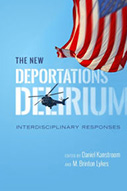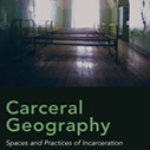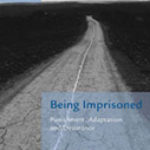The New Deportations Delirium: Interdisciplinary Responses

Editors: Daniel Kanstroom and M. Brinton Lykes
Publisher: New York: New York University Press, 2015.
Reviewers: Sarah Flinn and Cesar Cuauhtemoc Garcia Hernandez | March 2017
“[T]he laws say that a person who crosses [the border] is a criminal. It’s more criminal to let your children starve to death.” – Clara, a Salvadoran woman, regarding her decision to leave El Salvador and her four children (p. 209).
Immigration law enforcement policy is a maddening mess of quirky legal doctrines, unusual policing powers, and cross-border impacts. From war to economic policymaking, what happens in the United States frequently impacts life abroad – just as events outside the United States often reverberate here. Despite immigration policy’s multifaceted existence, advocates and scholars tend to segregate immigration into disciplinary silos. Lawyers consider law, social workers focus on family relations, psychologists concern themselves with mental well-being, and so on.
The New Deportations Delirium: Interdisciplinary Responses provides a refreshing antidote to that common and artificial treatment of immigration law enforcement practices. With contributions from professionals in a variety of disciplines, The New Deportations Delirium provides an in-depth analysis of the United States’ current immigration system and its most pernicious edges: the detention and deportation pipeline. Edited by longtime colleagues at Boston College, Daniel Kanstroom and M. Brinton Lykes, a lawyer and psychologist, respectively, each chapter provides a unique and discrete perspective that nonetheless remains tied to central themes that go a long way toward presenting a coherent narrative. The diverse group of contributors – including lawyers, judges, social workers, academic researchers, clinical and community psychologists, educators, community activists, and a filmmaker –sets The New Deportations Delirium apart from other books about immigration and embodies the project’s multidisciplinary approach.
Perhaps more importantly, the contributors are professionals advocating for reform from the various sites they occupy. For example, Dora Schriro, special advisor on immigration detention to Secretary of Homeland Security Janet Napolitano during 2009, summarizes the current state of immigration detention in the United States and provides her recommendations for reforming the nation’s immigration prison archipelago. Similarly, in-the-trenches insiders Immigration Judges Denise Noonan Slavin and Dana Leigh Marks critique the current classification of immigration judges as attorneys situated in the law-enforcement oriented Department of Justice rather than in an independent adjudicative agency.
Melding insider views with insightful analyses lodged from outside government, the volume successfully “support[s] and develop[s] . . . a systemic critique and a holistic professional model” (p. 9). Keeping these goals in mind, the book explores the intricacies of our current deportation-oriented immigration system and the effects on the individuals and families it touches. While analyzing and highlighting the numerous problems and failures of the current immigration system, the book provides well-defined, practical solutions and implementation plans to improve the system and address its major failings. These solutions include shifting the focus towards the best interests of the child, family unification, meeting human rights standards, and decreasing our dependence on detention. As with much immigration scholarship, the authors focus on law and political processes as the basis for many of the solutions. Refreshingly, they do not stop there. Multiple chapters highlight the importance of historical context and modern-day economic networks, from United States support of dictatorial Central American regimes in the 1980s to today’s global economy.
The framework for the book centers around two main inquiries: How does deportation affect individuals, families, and communities and what is the best approach to respond to the challenges presented by unauthorized migrants (p. 2)? Despite their varied backgrounds and experience, the contributors nonetheless begin with the shared perspective that the “United States has proudly considered itself to be a nation of immigrants” (p. 3). Tired at best, this description misses important nuances that The New Deportations Delirium explores in-depth.
Part 1 focuses on the legal, administrative, and political intricacies of U.S. immigration policy. The first four chapters lay out the challenges to comprehensive immigration reform while also providing proposals to address these challenges. Part 2 takes a more individual approach and examines the lives of migrants and those who work with them. These four chapters emphasize a multidisciplinary perspective to both research and advocacy. The research focuses on the empowerment of individuals and communities through participatory action research – research that aims to “situate researchers alongside migrants as knowledge co-producers and advocates, affirming [the migrants’] dignity and human rights” (p. 18). Each chapter focuses on a specific aspect of the overall experience of a migrant in the U.S. immigration system. Taken as a whole, this approach enables the reader to begin to comprehend the complex, confusing, unfair, and harmful system in place. For example, pairing chapters 1 and 6 demonstrates the effectiveness of this approach. Chapter 1 highlights the legal impacts of our current immigration system on families, while chapter 6 provides a synopsis of the psychological effects of detention and deportation on individuals and their families. The social research presented in the latter chapter contextualizes the legal overview in the former.
Reflecting the book’s adept ability to move from practical critiques to broader perspectives, The New Deportations Delirium provides much-needed historical context to explain migration from Central America. The history of United States military intervention in the region and continuing foreign policy decisions are commonly missing from the current immigration debate. Both chapters 7 and 8 provide an overview of the United States’ involvement in Central America (focusing on Guatemala and El Salvador, respectively). Additionally, these chapters analyze how past and present foreign policy continues to affect Central America economically, socially, and politically in such a way as to continue stimulating migration north. For example, chapter 7 summarizes United States intrusion in Guatemala, “culminating in its support for the Guatemalan military’s campaign against Mayan communities during the 36-year armed conflict” (p. 200). Not surprisingly, today there exists a sizeable Mayan Guatemalan population in the United States. In Massachusetts, this displaced population once again saw the strong arm of the state tear apart families: the Immigration and Customs Enforcement agency’s March 2007 raid of a large employer in Southeastern Massachusetts forced parents into detention and abandoned children to be cared for by anyone who would take them in (p. 202).
Chapters 7 and 8 argue that these long historical policies have provided and continue to provide many of the push factors that lead migrants to head north, despite the dangerous journey and numerous fears about leaving home. The quote that started this review, from a migrant referred to as Clara, demonstrates the complex struggle that many migrants face when deciding to migrate north: whether to leave behind children, spouses, families, and support networks (p. 209). For Clara, the decision was to either leave her children or to stay and let them starve – a decision that almost all parents would say is not a real decision at all. Clara’s sentiments, as well as the numerous other stories included in chapter 7, reiterate how U.S. foreign policy continues to lead to family separation and migration. Many of those people, as Katie Dingeman-Cerda and Rubén Rumbaut vividly describe in their chapter on El Salvador, are eventually deported, resulting in what they call a “new American diaspora” (p. 228).
As part of the goal to present guidelines for a multidisciplinary approach, chapter 5 explores some of the difficulties that can arise in the cross-disciplinary collaboration between lawyers and social workers. This chapter provides examples of how differing professional rules of conduct and varying objectives can cause tension between advocates. For example, lawyers tend to focus specifically on the legal issues presented by clients, whereas social workers frequently focus on empowering individual clients by focusing on the clients’ strengths (p. 149-150). While the goals of these two approaches are quite different, the focus remains on the individual, and by working together, a lawyer and a social worker are able to provide holistic assistance centered on the entirety of the individual’s circumstances. Despite possible difficulties and potential conflicts, the benefits to clients of having the advocacy of multiple professionals overwhelmingly points to the utility of a multidisciplinary approach (p. 164).
Although the book’s central focus on immigration law its interlacing themes are clear, at times The New Deportations Delirium can feel a bit disjointed. This is due, in part, to the diversity of contributors and the variety of topics covered. Perhaps more importantly, it is also because immigration law itself is very disjointed and broad. Individuals entangled in the immigration system frequently also have family and criminal law concerns; they might also be in desperate need of social services such as post-release planning, mental health care, and safety planning.
Furthermore, the rhetoric around immigration law frequently exchanges individuality for quantification: sweeping generalizations that dominate political conversations about the risks that migrants present hide the individual people – each with their own unique set of assets, problems, and challenges – that are the important, human aspect of immigration policies. While politicians frequently characterize this area of law as polarized—authorized or unauthorized, documented or undocumented, legal or illegal—the reality is that these are individuals who are each affected in distinctive ways. For strong policy change to occur, it is important to shift the focus from the abstract (fears and concerns regarding immigration) to the concrete (the human rights violations involved with our current immigration system). This is what The New Deportations Delirium does best. The group of experts that Kanstroom and Lykes gathered bring together the abstract concepts of immigration law, detention, human rights, and migration and transform them into a solid and relatable individual experience of enormous utility to professionals who work with migrant populations.
The New Deportations Delirium could have benefited from additional and more thorough reference to the international law and norms regarding immigration and immigration detention. Despite having all but abolished immigration detention by 1954, our immigration system has regressed and now relies heavily on detention. International law norms cast serious doubt on the detention practice. For example, the Organization of American States recently issued a report completed by the Inter-American Commission for Human Rights (IACHR) to the United States that concluded that the United States is “obligated to ensure the human rights of all persons including undocumented as well as documented immigrants. . .” (p. 63). Significantly, as part of this report, the OAS included rights such as personal liberty, humane treatment, and the protection of private and family life (p. 63). Meanwhile, the problems in immigration detention are legion. Health care is routinely shortchanged, deaths are not uncommon, and children are locked up for doing nothing more than seeking refuge here. Former detention policy head Schriro provides a brief overview of the applicable international law to U.S. treatment of migrants, but does so too briefly to do the topic justice (p. 62-63). In this vein, Jessica Chicco and Elaine Congress focus on one of the larger discrepancies between international law and U.S. immigration law: the lack of emphasis on the best interests of the child (p. 162).
As Schriro, Chicco, and Congress suggest, international law is not silent regarding immigration law. The very notion of asylum is rooted in post-World War II norms that have been incorporated into United States law. However, as Chicco and Congress point out, the U.S. government “does not consider itself bound by decisions of the Inter-American Commission, and has not altered its policies as a result” of criticism by that body (p. 162). Numerous commentators have lodged similar complaints—none more prominent than Justice Stephen Breyer in his recent book. Where the contributors fall short is in tackling the difficult question of whether this matters. Does United States resistance to international law mean abdication of international law tenets? In a recent article, Stephen Meili took the position that “while the incorporation of human rights treaties into domestic law does not guarantee more robust human rights protections for detained asylum seekers, it broadens the scope of the jurisprudential toolkit on which courts rely in adjudicating the rights of detainees.” The cross-disciplinary perspectives presented in The New Deportations Delirium could have added to this conversation, but they largely fail to do so.
Despite a few gaps, ultimately The New Deportations Delirium is a great resource for both newcomers to immigration law and those that are already familiar with the current debate. It is accessible and thoroughly covers many of the current problems and failures found in the U.S. immigration system. It also provides important insights into cross-disciplinary approaches to immigration law. Professionals can incorporate the emphasis on family unity to diversify their approach to any immigration law case. Realistically, it appears that The New Deportations Delirium met its stated goals of both critiquing the immigration system and providing a model for professionals to rely on in the fight to incorporate important human rights into our immigration system.
Sarah Flinn is a student at the University of Denver Sturm College of Law. César Cuauhtémoc García Hernández is an assistant professor at the University of Denver Sturm College of Law, publisher of crimmigration.com, and author of Crimmigration Law (2015).


